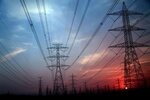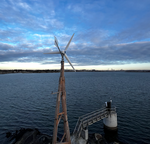News Release from GE Vernova
Wind Industry Profile of
08/30/2011
Product Pick of the Week - Development of superconducting magnets for MRI systems to scale-up wind turbines to 15 MW
GE researchers applying 30+ years of experience developing superconducting magnets for MRI systems to design an advanced generator for large-scale wind energy. GE researchers applying 30+ years of experience developing superconducting magnets for MRI systems to design an advanced generator for large-scale wind power. New generator will be lighter in weight, deliver more power, reduce cost of electricity (COE).
With the wind farm industry moving toward larger wind turbine platforms in the future, GE Global Research, the technology development arm of the General Electric Company, today announced it has begun work on the first phase of a 2-year, $3 million project from the U.S. Department of Energy to develop a next generation wind turbine generator that could support large-scale wind applications in the 10-15MW range. This project is one of many in GE’s wind research portfolio focused on scaling up wind power in the most economically feasible way.
“With the industry’s desire for higher megawatt machines to maximize clean wind power opportunities in the U.S. and around the globe, new technologies will be needed to support larger scale wind platforms,” said Keith Longtin, Wind Technology Leader, GE Global Research. “The key challenge will be delivering solutions that achieve the right scale and cost. Applying more than 30+ years of experience with superconducting magnets for MRI systems in healthcare, we’re developing an innovative new generator technology that will deliver more power while at the same time helping to reduce the cost of wind power.”
“For MRI systems, we’re applying superconducting magnets to make lower cost systems with higher image quality,” Longtin said. “For wind turbines, we want to apply them to generate more wind power at a lower cost of electricity. The applications are different, but the basic technology is the same.”
An electrical generator is the critical part of a wind turbine that converts the mechanical energy generated by the blades into usable electrical power. How effective your generator is directly impacts how much wind you can convert into electric power.
Today, most wind turbines have conventional generators that are connected to a gearbox. The gearbox is used to step up lower blade speeds into higher speeds, so that you can reduce the torque requirements before it reaches the generator. While extremely effective in wind turbines out in the field today, they will incur higher costs as you scale up to larger wind platforms because of additional weight and maintenance needs that will be required. You may get the additional power, but it will come with an increase in the cost of electricity.
Longtin explained that the innovative application of superconducting technology could enable significant improvements to the generator and make the elimination of the gearbox more economical. The keys are reducing the size and weight of the generator, while reducing speed and increasing torque. Utilizing superconducting technology reduces weight by virtue of the high magnetic fields that can be created by the superconducting field winding and the fact that the heavy iron in the superconducting generator can be reduced.
GE's superconducting machine design will employ a novel architecture and proven cryogenic cooling technology, resulting in an improvement in reliability of the complete machine. GE's proposed superconducting machine aims to have twice the torque density of competing technologies and will additionally reduce the dependence on the rare earth materials prevalent in all permanent magnet machines for wind. The larger power levels of these machines, coupled with their improved energy conversion efficiency leads to more favorable economies of scale (e.g., fewer towers for a given wind-farm output) that will help reduce the cost of energy produced by wind turbines.
In addition to the next generation wind turbine generator project, GE researchers are driving other key technologies that will enable the economic scale-up of wind. Major highlights include:
- Incorporating lighter, more advanced composite materials to enable longer wind blades that enhance wind capture without adding so much weight that it increases the cost of power;
- Delivering more advanced controls, sensors and condition monitoring algorithms to dramatically reduce operating costs; and
- Developing an array of grid integration technologies to seamlessly integrate larger amounts of wind into the grid. These technologies are focused on making sure wind turbines are grid-code compliant and provide new, grid-friendly features to help utilities more reliably manage larger wind power loads.
The next generation wind turbine generator project and other advanced technologies for wind are closely aligned with GE’s ecomagination initiative. Ecomagination represents the company’s commitment to deliver new clean products and technologies to market that help solve our toughest environmental challenges.
The generator project will have two phases. Phase I will focus on developing a conceptual design and evaluating the economic, environmental, and commercial factors associated with it. Phase II will explore the potential commercialization of the technology. The Oak Ridge National Lab (ORNL) will be a key partner with GE on the generator project, helping GE to investigate and mitigate high-risk technology challenges associated with the project.
GE Global Research is the hub of technology development for all of GE's businesses. Our scientists and engineers redefine what’s possible, drive growth for our businesses and find answers to some of the world’s toughest problems.
We innovate 24 hours a day, with sites in Niskayuna, New York; Bangalore, India; Shanghai, China; Munich, Germany; and fifth global research facility to open in Rio de Janeiro, Brazil in 2012.
For more information on this article or if you would like to know more about what www.windfair.net can offer, please do not hesitate to contact Trevor Sievert at ts@windfair.net
www.windfair.net is the largest international B2B Internet platform – ultimately designed for connecting wind energy enthusiasts and companies across the globe!
With the wind farm industry moving toward larger wind turbine platforms in the future, GE Global Research, the technology development arm of the General Electric Company, today announced it has begun work on the first phase of a 2-year, $3 million project from the U.S. Department of Energy to develop a next generation wind turbine generator that could support large-scale wind applications in the 10-15MW range. This project is one of many in GE’s wind research portfolio focused on scaling up wind power in the most economically feasible way.
“With the industry’s desire for higher megawatt machines to maximize clean wind power opportunities in the U.S. and around the globe, new technologies will be needed to support larger scale wind platforms,” said Keith Longtin, Wind Technology Leader, GE Global Research. “The key challenge will be delivering solutions that achieve the right scale and cost. Applying more than 30+ years of experience with superconducting magnets for MRI systems in healthcare, we’re developing an innovative new generator technology that will deliver more power while at the same time helping to reduce the cost of wind power.”
“For MRI systems, we’re applying superconducting magnets to make lower cost systems with higher image quality,” Longtin said. “For wind turbines, we want to apply them to generate more wind power at a lower cost of electricity. The applications are different, but the basic technology is the same.”
An electrical generator is the critical part of a wind turbine that converts the mechanical energy generated by the blades into usable electrical power. How effective your generator is directly impacts how much wind you can convert into electric power.
Today, most wind turbines have conventional generators that are connected to a gearbox. The gearbox is used to step up lower blade speeds into higher speeds, so that you can reduce the torque requirements before it reaches the generator. While extremely effective in wind turbines out in the field today, they will incur higher costs as you scale up to larger wind platforms because of additional weight and maintenance needs that will be required. You may get the additional power, but it will come with an increase in the cost of electricity.
Longtin explained that the innovative application of superconducting technology could enable significant improvements to the generator and make the elimination of the gearbox more economical. The keys are reducing the size and weight of the generator, while reducing speed and increasing torque. Utilizing superconducting technology reduces weight by virtue of the high magnetic fields that can be created by the superconducting field winding and the fact that the heavy iron in the superconducting generator can be reduced.
GE's superconducting machine design will employ a novel architecture and proven cryogenic cooling technology, resulting in an improvement in reliability of the complete machine. GE's proposed superconducting machine aims to have twice the torque density of competing technologies and will additionally reduce the dependence on the rare earth materials prevalent in all permanent magnet machines for wind. The larger power levels of these machines, coupled with their improved energy conversion efficiency leads to more favorable economies of scale (e.g., fewer towers for a given wind-farm output) that will help reduce the cost of energy produced by wind turbines.
In addition to the next generation wind turbine generator project, GE researchers are driving other key technologies that will enable the economic scale-up of wind. Major highlights include:
- Incorporating lighter, more advanced composite materials to enable longer wind blades that enhance wind capture without adding so much weight that it increases the cost of power;
- Delivering more advanced controls, sensors and condition monitoring algorithms to dramatically reduce operating costs; and
- Developing an array of grid integration technologies to seamlessly integrate larger amounts of wind into the grid. These technologies are focused on making sure wind turbines are grid-code compliant and provide new, grid-friendly features to help utilities more reliably manage larger wind power loads.
The next generation wind turbine generator project and other advanced technologies for wind are closely aligned with GE’s ecomagination initiative. Ecomagination represents the company’s commitment to deliver new clean products and technologies to market that help solve our toughest environmental challenges.
The generator project will have two phases. Phase I will focus on developing a conceptual design and evaluating the economic, environmental, and commercial factors associated with it. Phase II will explore the potential commercialization of the technology. The Oak Ridge National Lab (ORNL) will be a key partner with GE on the generator project, helping GE to investigate and mitigate high-risk technology challenges associated with the project.
GE Global Research is the hub of technology development for all of GE's businesses. Our scientists and engineers redefine what’s possible, drive growth for our businesses and find answers to some of the world’s toughest problems.
We innovate 24 hours a day, with sites in Niskayuna, New York; Bangalore, India; Shanghai, China; Munich, Germany; and fifth global research facility to open in Rio de Janeiro, Brazil in 2012.
For more information on this article or if you would like to know more about what www.windfair.net can offer, please do not hesitate to contact Trevor Sievert at ts@windfair.net
www.windfair.net is the largest international B2B Internet platform – ultimately designed for connecting wind energy enthusiasts and companies across the globe!
- Source:
- General Electric
- Author:
- Posted by Trevor Sievert, Online Editorial Journalist
- Email:
- windenergy.germany@ps.ge.com
- Link:
- www.ge.com/...
- Keywords:
- wind, wind energy, wind turbine, General Electric, rotorblade, awea, ewea, wind power, suppliers, manufacturerstrevor sievert








